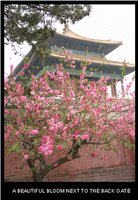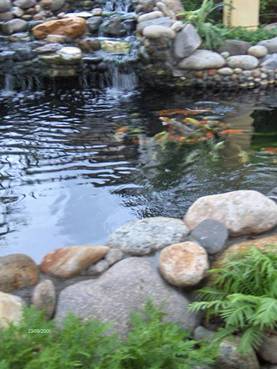A MUST VISIT
When I first
 made plans to travel to China it was intended for business purpose with two extra days thrown in for sight seeing. We booked a booth at the Franchise China Expo 2006 held at the World Trade Centre in Beijing an event sponsored by Matrade, a division of the Ministry of Trade entrusted to promote Malaysia to the world.
made plans to travel to China it was intended for business purpose with two extra days thrown in for sight seeing. We booked a booth at the Franchise China Expo 2006 held at the World Trade Centre in Beijing an event sponsored by Matrade, a division of the Ministry of Trade entrusted to promote Malaysia to the world.While we do not know what to expect having received mild success in Shanghai last year we nevertheless hope for the best. The exhibition spanned over 3 ½ days and was participated by some 200 companies, mainly Chinese organizations. Most of the companies exhibited the franchise of consumer products. Our booth drew much interest and we have a couple of serious enquiries with one making a visit to KL mid May to see first hand our business model.
The experience nevertheless left me with an even greater impact of what China has to offer in all aspect of our life. We have always known that China is big and the diversity it provides makes for interesting visit. But it is only until we see first hand do we understand the meaning of BIG. For those of us who are western educated, it is normal to place China last in our travel plans, and only when we have seen most of the western world do we make a beeline for China. This will however change when you step foot on the middle kingdom. Whether you are the
 re for sight-seeing, business, education, shopping, a taste of its culture, food, art or sports, China does not cease to amaze you. And if affordable holiday is what you are looking for, then this destination is the one for you especially given the increasingly higher cost of airfares, the result of higher fuel prices.
re for sight-seeing, business, education, shopping, a taste of its culture, food, art or sports, China does not cease to amaze you. And if affordable holiday is what you are looking for, then this destination is the one for you especially given the increasingly higher cost of airfares, the result of higher fuel prices.There was a time (about 20 years ago) when Malaysians were not allowed to visit China without approval from the government. This makes China rather intriguing, especially when we have read so much about the history and geographical attractions of China. Now that there is no restriction in travel, we tend to think that it can be deferred. But procrastinate no further.
If you are one who is attracted to its rich heritage and history, then the visit to the Forbidden City, Summer Palace and Great Wall is sure to inspire you. A journey to Beijing is not complete without visiting these places. I am not one for history, but it will
 help if I had read before hand or viewed the many movies depicting Chinese history.
help if I had read before hand or viewed the many movies depicting Chinese history.The Forbidden City, lying at the center of Beijing (also called Gu Gong in Chinese), was the imperial palace during the Ming and Qing dynasties. It is now known as the Palace Museum. My colleague Allen was so taken in by the sight that he made the most of his entry into the Forbidden City reading the many notices placed outside the exhibits.
A Tang Dynasty poet wrote a line about the royal palace of his time, which says "Without seeing the magnificence of the royal palace, one can never sense the dignity of the emperor."
To illustrate the vast expanse of the palace ground which covers 74 hectares; Allen told me there are altogether 8000 over houses in the compound which would mean that a day’s visit would not be sufficient for those who intends to catch all its attractions. As he made his way around the city he related portions of the rich history of the past, the rise and fall of each emperor, their wisdom and legacy. There are unique and delicately structured towers on each of the four corners of the curtain wall. These afford views over both the palace and the city outside. Until 1924 when the last emperor of China was driven from the Inner Court, fourteen emperors of the Ming dynasty and ten emperors of the Qing dynasty reigned here. It houses numerous rare treasures and curiosities. To Allen it was like
 reliving the past, from what he has read in books and seen from movie reenactment of the rule under various emperors by directors who preserved much of what was recorded. It was interesting but for those of us who are hearing it for the first time it was rather a lot to digest. Now that I have been introduced to the subject and have seen it personally, I am more inclined to read the history books.
reliving the past, from what he has read in books and seen from movie reenactment of the rule under various emperors by directors who preserved much of what was recorded. It was interesting but for those of us who are hearing it for the first time it was rather a lot to digest. Now that I have been introduced to the subject and have seen it personally, I am more inclined to read the history books.A short walk south of the palace lie the Tiananmen square, the location of students protest and government crackdown where the army fought its way past barricades in June 1989. All around are magnificent buildings housing the China National Museum, the Great Hall of the China National People’s Congress and Chairman Mao's mausoleum where his body lies in a crystal coffin. Here as well as in many parts of China, tourists of all nationalities throng the places of interest numbering tens of thousands each day bringing with them large sums of foreign exchange; significant contribution to the country’s economy.
 The Great Wall of China thought to be visible from the moon is one of the Seven Wonders of the World. This makes the visit almost mandatory if one is to claim having been to Beijing. The Great Wall of China was built over 2,000 years ago, by Emperor Shi Huangdi, the first emperor of China during the Qin (Ch'in) Dynasty (221 B.C - 206 B.C.). In Chinese the wall is called "Wan-Li Qang-Qeng" which means 10,000-Li Long Wall (10,000 Li = about 5,000 km). During the Ming Dynasty (1368-1644), the Great Wall was enlarged to 6,400 kilometers (4,000 miles) and renovated over a 200 year period, with watch-towers and cannons added. We visited the Badaling Great Wall located 70km northwest of Beijing, the earliest section to be open to tourists. Built from the end of the 14th century until the beginning of the 17th century, during the Ming Dynasty, it protected China from raids by the Mongols and Turkic tribes. The top of the wall can permit five horses to be ridden abreast. There are arched doors at the inner side of the wall with very little distance between each two doors. It was an awe-inspiring experience to walk along the top of the wall which meanders along the hills and one wonders how early day Chinese were able to construct without modern day equipment and technology. The coolness of the air makes walking along the wall a delightful experience, with breathtaking scenery and lots of photo-taking opportunities. Certain portions of the journey are rather steep and the exercise is good for the body.
The Great Wall of China thought to be visible from the moon is one of the Seven Wonders of the World. This makes the visit almost mandatory if one is to claim having been to Beijing. The Great Wall of China was built over 2,000 years ago, by Emperor Shi Huangdi, the first emperor of China during the Qin (Ch'in) Dynasty (221 B.C - 206 B.C.). In Chinese the wall is called "Wan-Li Qang-Qeng" which means 10,000-Li Long Wall (10,000 Li = about 5,000 km). During the Ming Dynasty (1368-1644), the Great Wall was enlarged to 6,400 kilometers (4,000 miles) and renovated over a 200 year period, with watch-towers and cannons added. We visited the Badaling Great Wall located 70km northwest of Beijing, the earliest section to be open to tourists. Built from the end of the 14th century until the beginning of the 17th century, during the Ming Dynasty, it protected China from raids by the Mongols and Turkic tribes. The top of the wall can permit five horses to be ridden abreast. There are arched doors at the inner side of the wall with very little distance between each two doors. It was an awe-inspiring experience to walk along the top of the wall which meanders along the hills and one wonders how early day Chinese were able to construct without modern day equipment and technology. The coolness of the air makes walking along the wall a delightful experience, with breathtaking scenery and lots of photo-taking opportunities. Certain portions of the journey are rather steep and the exercise is good for the body.A visit to Beijing must include the shopping experience of the Silk Street market much like the flea market at Xian Yang street in Shanghai, only more comfortable (with air-conditioning and clean floors) minus the touts. The market housed over four floors is located close to the world trade centre and embassies. It is a shopping paradise for those seeking designer brands but not the price. Bags, garments, shoes, ties, belts and many others of famous bran
 d name like Versace, Nike, Channel, Swiss Army, Adidas lined the shop fronts. But the most memorable experience is the bargaining which one learns as he moves from shops to shops. And it takes a very disciplined shopper not to over-spend as the items on display are tempting to the eyes and the retailers very skilled at persuasion. Never mind if you do not have luggage space as the luggage bags shops are plentiful with modern designs and are inexpensive. And if this is insufficient for your appetite, there is the Wanfujing and Xidan street where rows of shops on both side of the street invites you to part with your Rmb.
d name like Versace, Nike, Channel, Swiss Army, Adidas lined the shop fronts. But the most memorable experience is the bargaining which one learns as he moves from shops to shops. And it takes a very disciplined shopper not to over-spend as the items on display are tempting to the eyes and the retailers very skilled at persuasion. Never mind if you do not have luggage space as the luggage bags shops are plentiful with modern designs and are inexpensive. And if this is insufficient for your appetite, there is the Wanfujing and Xidan street where rows of shops on both side of the street invites you to part with your Rmb.Well I have taken some time to introduce Beijing, the rest is up to you. If you need a travel guide, buy me a ticket and I am on the plane with you. Cheers!

No comments:
Post a Comment